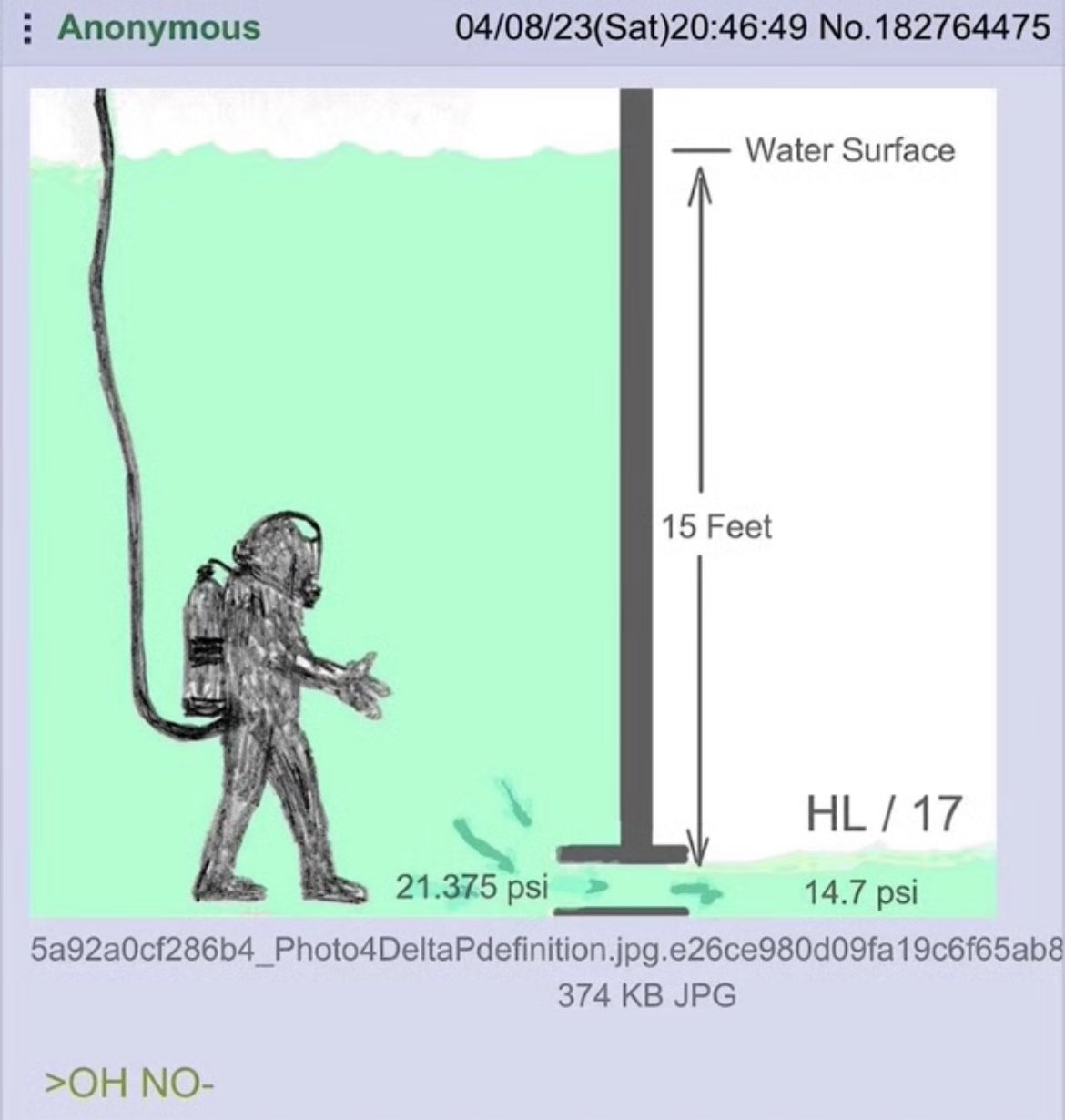this post was submitted on 28 Dec 2024
358 points (97.1% liked)
Greentext
4686 readers
1689 users here now
This is a place to share greentexts and witness the confounding life of Anon. If you're new to the Greentext community, think of it as a sort of zoo with Anon as the main attraction.
Be warned:
- Anon is often crazy.
- Anon is often depressed.
- Anon frequently shares thoughts that are immature, offensive, or incomprehensible.
If you find yourself getting angry (or god forbid, agreeing) with something Anon has said, you might be doing it wrong.
founded 1 year ago
MODERATORS
you are viewing a single comment's thread
view the rest of the comments
view the rest of the comments

Wouldn't this human in theory become a crumpled sausage like what happened to the crab by the leaking underwater pipe?
Not at 15 feet. I don't know enough to say how fast the water would be leaving that hole, but it's maybe a couple hundred pounds of pressure. If he even got caught, it would be super uncomfortable, but he ain't about to get ∆p'd
If you wanna see a real crab-in-a-pipe situation, look up that Byford Dolphin everyone's talking about
Let's convert to metric so we can tell.
15 ft is about 5 m.
Water pressure increases by 10,000 pa per meter (rhogh, rho=1000 kg/m^3, g~10m/s^2), so total pressure is 50 kpa, or 1/2 earth atmospheric pressure.
One side of that hole has ambient pressure of 1 atm. The other side has that plus water pressure totalling 1.5 atm.
A pressure is just an energy density. Multiply by the cross-sectional area of the interface to get the energy gradient across the interface. An energy gradient is a force. We don't have a measure of the cross-sectional area of the hole, but if we expect a person to fit through let's call it 1m^2.
50 kpa = 50 kJ/m^3, so total force felt across this opening is 50kN which is the equivalent weight of five metric tons.
Size of the hole absolutely matters. If it's only the size of a fist (10cm x 10cm) then instead of 5 metric tons it's only 50 kg of equivalent weight, or about the weight of a person and easily survivable.
This is very interesting. I like unit conversions.
What I did was just take 21-14 psi, and then converted that to bar or atm. I got a number close to ½.
I was like, half an atm? Can't be that bad? I can handle 1 full mf atm literally all mf day mf.
But I guess that's different somehow? I just don't understand how yet. If anyone would care to go into it with me... 🙏
Remember a vacuum does not have suction it's the air that presses things under vacuum together. One atm is actually quite a lot but we can withstand that as it's pressing at us from all sides including inside.
See this example of how strong 1 atm can be
The atmosphere is big and heavy. Small pressure changes on order 1% means hurricane. 50% of an atmosphere pushing on something is a lot.
Note, this is all Earth's atmosphere.
Titan's atmosphere is energy-denser than ours at 1.5 atm. Titan is Saturn's largest moon.
Venus has 96 atm. Absolutely crushing and hard to visit at all.
Mars varies from like 0.3-0.6% seasonally as significant portions of its CO2 atmosphere deposit onto the poles as dry ice glaciers in a runaway greenhouse style. CO2 snows out, temps drop, more snows. Keeps going till the sun comes back. Sunlight sublimates the ice back into the atmosphere in a similar runaway fashion. Like a deep breath in and out with the seasons. The weight of all that ice falling and leaving keeps that red lump beating every year. Don't believe those who say Mars is dead. We don't know yet. Don't count out anything with a breath and a beat. What is life on a planetary scale, anyhow?
The gas giants have atmospheric pressures so high it kind of stops making sense to use these as comparisons, and instead we have to look to geology for analogues as deep within the earth we also approach these energy densities.